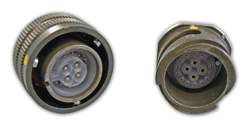An overview of the role of connectors in portable medical applications
BY WAYDE KING and CARL BUNKE
ITT Interconnect Solutions
White Plains, NY
http://www.ittcannon.com
As medical equipment continues to evolve and become more portable, how these devices are interconnected is continuously changing as well. Innovative designs in connector and contact technology are becoming increasingly important to support evolving requirements such as rugged environments, high mating cycles, and high reliability.
Defibrillators and other high-voltage medical equipment are becoming more portable, particularly as they are often being carried in helicopters, ambulances, and other vehicles to the scene of an accident. As a result, top medical device manufacturers are looking for robust equipment that can withstand extreme shock and vibration, as well as environmental elements. These devices are also routinely used in relatively benign environments such as hospitals, meaning that they must not only be designed for rugged use, but they must also be cost-effective enough for both areas.
Connector technology
Connector designs are not immune to the often conflicting requirements of being both rugged and cost-effective. When it comes to connectors, Tier One medical OEMs frequently require completely tooled components and complete overmolded connectors with harness assemblies. Key requirements include a robust design with a high number of connection cycles, as well as a compact configuration to meet the reduced footprint of portable equipment.
Some highly versatile multi-pin connectors are being designed into high-voltage portable medical equipment as an alternative to traditional connector designs that experience quality and reliability issues due to high-vibration environments. Connectors that were originally designed for harsh transit and/or military applications are ideal for use in medical equipment, as the electrical parameters of these components often meet strict military specifications. Features such as positive lock, quick disconnect coupling, and water tight sealing can, in some cases, exceed the environmental requirements of most military applications, thus making them ideal for medical field use.
The use of circular “bayonet-style” connectors such as ITT’s VBN and CIR series are widely used and accepted for their positive locking mechanisms, quick disconnect coupling, and easy installation. Plus, these designs often afford the ability to mix power, signal, coax, or pneumatic contacts within a single insert arrangement, significantly increasing versatility for a variety of medical equipment needs. Such designs may also feature a silicon grommet on the back of the connector, sealing the wires against humidity and water penetration, while an anti-vibration cable clamp keeps the wires in place.

Circular bayonet connector technology is frequently being deployed in high-voltage medical applications.
In the case of defibrillators, connectors must be able to withstand extremely high voltage, prompting some manufacturers to design “towers” into the connectors that allow them to withstand up to 7.5 kV by increasing the electrical path between contacts. Another feature that is added to increase the reliability of the connector system is a “scoop-proof” design, meaning a plug can not be inserted incorrectly into the receptacle, preventing damage to the contacts and providing further protection against accidental mismating.
Connectors with the features mentioned above, along with a compact package size and a high pin count, are important elements in meeting customer requirements. Their high voltage capabilities and multiple signal contacts enable them to replace traditional connector solutions in defibrillators and other portable medical equipment.
Contact technology
Contact technology also plays an integral role in the design of connectors for medical devices. Because having highly reliable contact systems is paramount in portable medical equipment, some connector manufacturers design “hyperboloid” contact systems, which include multiple points of contact, positive wiping action, and a closed entry to guide the mating pin for thousands of cycles without degrading the signal integrity.
Hyperboloid contact systems feature extremely low insertion force and are typically immune to shock and vibration. Other contact options include a pad/pogo connector for ease of field maintenance or a twist pin connector for reliable small form factor applications. Connector manufacturers are adapting these contact systems for other areas as well, including military applications, radio and power supply cables, test equipment, and even hospital bedside monitoring equipment to provide reliable connections even after a high number of mating cycles for constant connection and disconnection.
Shell and contact materials
The materials used in connectors for portable medical equipment must be robust. Aluminum or composite alloy shells with copper alloy or thermocouple contact materials are commonly employed for their high reliability. Copper-alloy plated contacts with metal retention clips and thermoplastic inserts pave the way for a robust connection to meet the environmental requirements of portable medical devices. ■
Advertisement
Learn more about ITT Interconnect Solutions





